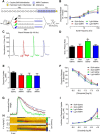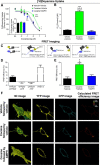Amphetamine Reverses Escalated Cocaine Intake via Restoration of Dopamine Transporter Conformation
- PMID: 29175958
- PMCID: PMC5761621
- DOI: 10.1523/JNEUROSCI.2604-17.2017
Amphetamine Reverses Escalated Cocaine Intake via Restoration of Dopamine Transporter Conformation
Abstract
Cocaine abuse disrupts dopamine system function, and reduces cocaine inhibition of the dopamine transporter (DAT), which results in tolerance. Although tolerance is a hallmark of cocaine addiction and a DSM-V criterion for substance abuse disorders, the molecular adaptations producing tolerance are unknown, and testing the impact of DAT changes on drug taking behaviors has proven difficult. In regard to treatment, amphetamine has shown efficacy in reducing cocaine intake; however, the mechanisms underlying these effects have not been explored. The goals of this study were twofold; we sought to (1) identify the molecular mechanisms by which cocaine exposure produces tolerance and (2) determine whether amphetamine-induced reductions in cocaine intake are connected to these mechanisms. Using cocaine self-administration and fast-scan cyclic voltammetry in male rats, we show that low-dose, continuous amphetamine treatment, during self-administration or abstinence, completely reversed cocaine tolerance. Amphetamine treatment also reversed escalated cocaine intake and decreased motivation to obtain cocaine as measured in a behavioral economics task, thereby linking tolerance to multiple facets of cocaine use. Finally, using fluorescence resonance energy transfer imaging, we found that cocaine tolerance is associated with the formation of DAT-DAT complexes, and that amphetamine disperses these complexes. In addition to extending our basic understanding of DATs and their role in cocaine reinforcement, we serendipitously identified a novel therapeutic target: DAT oligomer complexes. We show that dispersion of oligomers is concomitant with reduced cocaine intake, and propose that pharmacotherapeutics aimed at these complexes may have potential for cocaine addiction treatment.SIGNIFICANCE STATEMENT Tolerance to cocaine's subjective effects is a cardinal symptom of cocaine addiction and a DSM-V criterion for substance abuse disorders. However, elucidating the molecular adaptions that produce tolerance and determining its behavioral impact have proven difficult. Using cocaine self-administration in rats, we link tolerance to cocaine effects at the dopamine transporter (DAT) with aberrant cocaine-taking behaviors. Further, tolerance was associated with multi-DAT complexes, which formed after cocaine exposure. Treatment with amphetamine deconstructed DAT complexes, reversed tolerance, and decreased cocaine seeking. These data describe the behavioral consequence of cocaine tolerance, provide a putative mechanism for its development, and suggest that compounds that disperse DAT complexes may be efficacious treatments for cocaine addiction.
Keywords: agonist therapy; behavioral economics; nucleus accumbens; self-administration; tolerance; voltammetry.
Copyright © 2018 the authors 0270-6474/18/380484-14$15.00/0.
Figures







References
Publication types
MeSH terms
Substances
Grants and funding
LinkOut - more resources
Full Text Sources
Other Literature Sources
Medical
